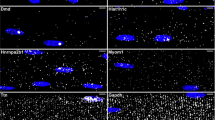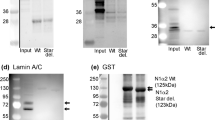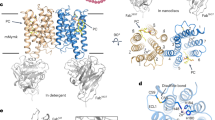Abstract
The localization of gene products is central to the development of cell polarity1,2 and pattern specification during embryogenesis3–5. To monitor the distribution of gene products encoded by different nuclei in the same cell in tissue culture, we fused cells of different species to form multinucleated non-dividing heterokaryons6,7. In previous fusion studies, cell-surface antigens and organelles contributed by disparate cell types intermixed within minutes8–11. Using heterokaryons produced with differentiated muscle cells, we demonstrate here that a muscle membrane component, the Golgi apparatus mediating its transport, and a sarcomeric myosin heavy chain are localized in the vicinity of the nuclei responsible for their synthesis. These results provide direct evidence that products (organelle, membrane and structural proteins) derived from individual nuclei can remain localized in myotubes, a finding with implications both for neuromuscular synapse formation and for the carrier state of Duchenne muscular dystrophy.
This is a preview of subscription content, access via your institution
Access options
Subscribe to this journal
Receive 51 print issues and online access
$199.00 per year
only $3.90 per issue
Buy this article
- Purchase on Springer Link
- Instant access to full article PDF
Prices may be subject to local taxes which are calculated during checkout
Similar content being viewed by others
References
Misek, D. E., Bard, E. & Rodriguez-Boulan, E. Cell 39, 537–546 (1984).
Segev, N., Mulholland, J. & Botstein, D. Cell 52, 915–924 (1988).
Gurdon, J. B., Mohun, T. J., Fairman, S. & Brennan, S. Proc. natn. Acad. Sci. U.S.A. 82, 139–143 (1985).
Melton, D. A. Nature 328, 80–82 (1987).
Driever, W. & Nüsslein Volhard, C. Cell 54, 83–93 (1988).
Blau, H. M., Chiu, C.-P. & Webster, C. Cell 32, 1171–1180 (1983).
Blau, H. M. et al. Science 230, 758–766 (1985).
Watkins, J. F. & Grace, D. M. J. Cell Sci. 2, 193–204 (1967).
Harris, H., Sidebottom, E., Grace, D. M. & Bramwell, M. E. J. Cell Sci. 4, 499–525 (1969).
Frye, L. D. & Edidin, M. J. Cell Sci. 7, 319–335 (1970).
Tassin, A.-M., Maro, B. & Bornens, M. J. Cell Biol. 100, 35–46 (1985).
Englander, L. L. & Rubin, L. L. J. Cell Biol. 104, 87–95 (1987).
Webster, C., Silberstein, L., Hays, A. P. & Blau, H. M. Cell 52, 503–513 (1988).
Hardeman, E., Chiu, C.-P., Minty, A. & Blau, H. M. Cell 47, 123–130 (1986).
Ash, J. F., Louvard, D. & Singer, S. J. Proc. natn. Acad. Sci. U.S.A. 74, 5584–5588 (1977).
Stya, M. & Axelrod, D. Proc. natn. Acad. Sci. U.S.A. 80, 449–453 (1983).
Bursztajn, S., McManaman, J. L., Elias, S. B. & Appel, S. H. Science 219, 195–196 (1983).
Isaacs, W. B. & Fulton, A. B. Proc. natn. Acad. Sci. U.S.A. 84, 6174–6178 (1987).
Taylor, L. D. & Bandman, E. J. Cell Biol. (in the press).
Kawata, S., Lehner, C., Müller, M. & Cherry, R. C. J. biol. Chem. 257, 6470–6476 (1982).
Edelman, G. M. Science 192, 218–226 (1976).
Merlie, J. P. & Sanes, J. R. Nature 317, 66–68 (1985).
Fontaine, B., Sassoon, D., Buckingham, M. & Changeux, J.-P. EMBO J. 7, 603–609 (1988).
Salviati, G., Biasia, E. & Aloisi, M. Nature 322, 637–639 (1986).
Hausmanowa-Petrusewicz, I., Niebroj-Dobosz, I., Borkowska, J., Lukasik, E. & Liszewska-Pfejfer, D. in Pathogenesis of Human Muscular Dystrophies (ed. Rowland, L. P.) (Excerpta Medica, Oxford, 1977).
Hoffman, E. P., Brown, R. H. & Kunkel, L. M. Cell 51, 919–928 (1987).
Webster, C., Pavlath, G. K., Parks, D. R., Walsh, F. S. & Blau, H. M. Expl Cell Res. 174, 252–265 (1988).
Berger, E. G., Mandel, T. & Schilt, U. J. Histochem. Cytochem. 29, 364–370 (1981).
Tassin, A.-M., Paintrand, M., Berger, E. G. & Bornens, M. J. Cell Biol. 101, 630–638 (1985).
Kronebusch, P. J. & Singer, S. J. J. Cell Sci. 88, 25–34 (1987).
Miller, S. C., Pavlath, G. K., Blakely, B. T. & Blau, H. M. Genes Dev. 2, 330–340 (1988).
Author information
Authors and Affiliations
Rights and permissions
About this article
Cite this article
Pavlath, G., Rich, K., Webster, S. et al. Localization of muscle gene products in nuclear domains. Nature 337, 570–573 (1989). https://doi.org/10.1038/337570a0
Received:
Accepted:
Issue Date:
DOI: https://doi.org/10.1038/337570a0
This article is cited by
-
Microtubule-based transport is essential to distribute RNA and nascent protein in skeletal muscle
Nature Communications (2021)
-
Systemic cell therapy for muscular dystrophies
Stem Cell Reviews and Reports (2021)
-
Myonuclear content regulates cell size with similar scaling properties in mice and humans
Nature Communications (2020)
-
Single-nucleus transcriptomics reveals functional compartmentalization in syncytial skeletal muscle cells
Nature Communications (2020)
-
Chemoradiation impairs myofiber hypertrophic growth in a pediatric tumor model
Scientific Reports (2020)
Comments
By submitting a comment you agree to abide by our Terms and Community Guidelines. If you find something abusive or that does not comply with our terms or guidelines please flag it as inappropriate.



